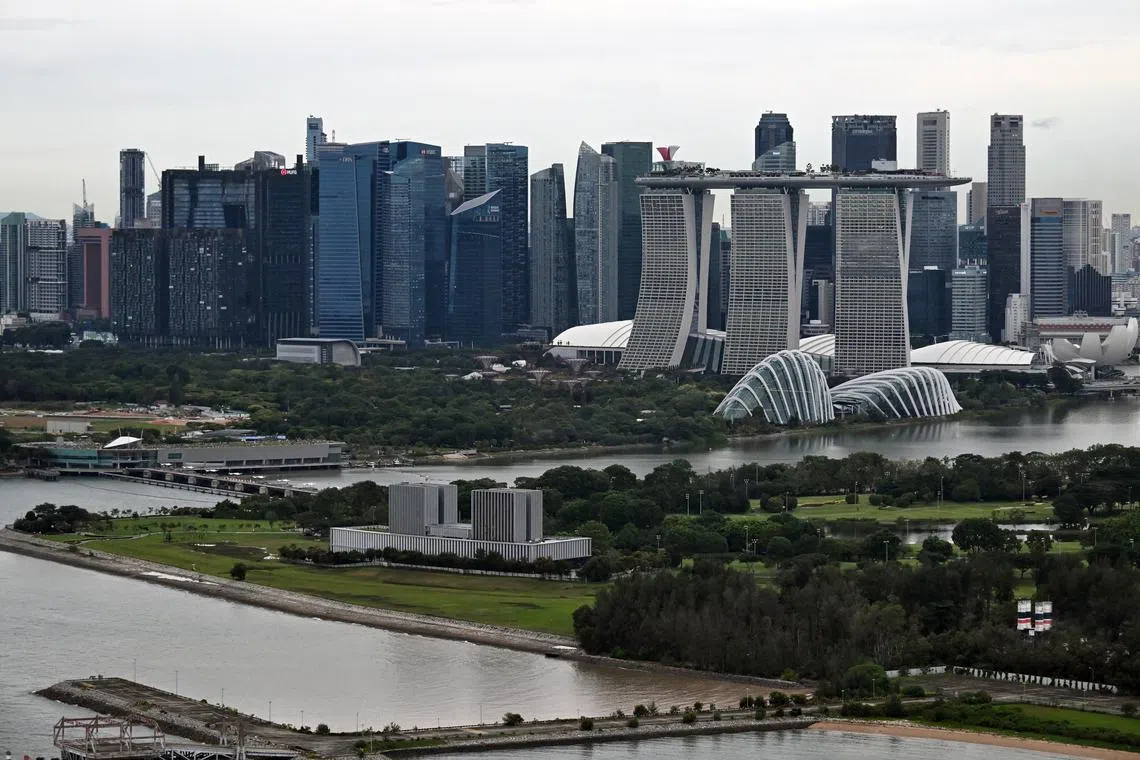Economists raise Singapore’s 2024 growth forecast to 2.6%: MAS survey
Sign up now: Get ST's newsletters delivered to your inbox

GDP growth would be backed by finance and insurance, construction and wholesale and retail trade sectors, the survey showed.
ST PHOTO: KUA CHEE SIONG
Follow topic:
SINGAPORE - Private-sector economists raised their 2024 outlook for Singapore’s economic growth and lowered their forecast for inflation.
Professional forecasters in the quarterly survey released by the Monetary Authority of Singapore (MAS) on Sept 11 expect gross domestic product (GDP) to expand 2.6 per cent in 2024, up from 2.4 per cent in the June survey.
GDP growth would be backed by the finance and insurance, construction, and wholesale and retail trade sectors, the survey showed.
However, the forecasters slashed the growth outlook for the key manufacturing sector to 0.6 per cent, from 1.6 per cent in the previous survey. With the manufacturing outlook reduced, the pace of growth in non-oil domestic exports was cut to 3 per cent from 4 per cent.
Conversely, the finance and insurance sector was tipped to grow 5.7 per cent, up from 5.1 per cent in the June survey. Growth in construction was raised to 3.9 per cent from 3.8 per cent. Wholesale and retail trade was seen growing at 3 per cent, up from 2.5 per cent.
Private consumption – or household spending on goods and services – was likely to grow by 5.5 per cent, higher than the previous forecast of 3.4 per cent, according to the survey.
The upgrade of GDP growth expectations comes after the economy expanded by 2.9 per cent year on year in the second quarter of 2024, above the survey respondents’ median forecast of 2.7 per cent in the June survey.
The Ministry of Trade and Industry (MTI) in August also narrowed Singapore’s 2024 growth forecast to a range of 2 per cent to 3 per cent, from an earlier estimate of 1 per cent to 3 per cent.
Analysts said the lower manufacturing growth forecast of 0.6 per cent in the survey reflected the weaker-than-expected performance of the sector in the second quarter.
Mr Chua Han Teng, an economist at DBS Bank, said the figure would still be a turnaround from the declines of 1.4 per cent in the first half of 2024 and the 4.3 per cent drop in 2023.
More recent data actually shows that manufacturing output started the third quarter on a positive note, expanding 1.8 per cent year on year in July, after contracting 4.3 per cent in June.
“The performance of the electronics cluster, which accounts for nearly half of Singapore’s manufacturing output, will be key in driving the overall factory recovery in the second half of 2024,” Mr Chua said.
“We continue to expect Singapore’s electronics firms to capitalise on the global technology upcycle, driven by the replacement of smartphones and computers, as well as the broadening adoption of artificial intelligence applications,” he noted.
For 2025, the MAS survey respondents see GDP expanding by 2.5 per cent, unchanged from the June survey. MTI has not announced any forecast for 2025.
The economists’ median forecast for 2024 all-items inflation was cut to 2.6 per cent from 2.8 per cent in the June survey. They also lowered their median estimate for MAS core inflation – which excludes private transport and accommodation costs – to 2.9 per cent, from the earlier 3 per cent.
Both all-items and core inflation are expected to ease further to 2 per cent in 2025, the survey showed.
Singapore’s unemployment rate is expected to stand at 2.1 per cent at the year end, unchanged from the previous forecast.
A slowdown in global economic growth, which drives Singapore exports and manufacturing, emerged as the most cited downside risks to Singapore’s growth outlook. Respondents also flagged spillovers from geopolitical tensions, including from higher US tariffs and weaker growth in China.
However, the balance of risks was in favour of an upside surprise from a better-than-expected external growth environment. The upside surprise to Singapore’s outlook was cited by 73 per cent of respondents.
Respondents also flagged more robust growth in China and faster-than-expected tech cycle recovery as key upside surprises.
The majority of the respondents do not expect any changes to Singapore’s monetary policy in MAS’ October review. MAS currently favours an appreciating Singapore dollar that is aimed at keeping imported inflation in check.
But for MAS’ January policy review, half of the respondents anticipate an easing of the strong Singapore dollar stance.


